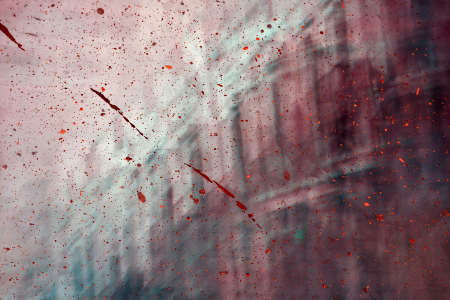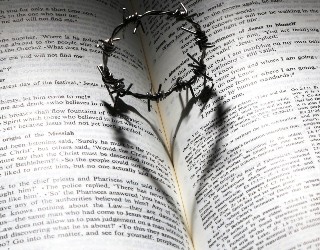We ask you, humbly: don't scroll away.
Hi readers, it seems you use Catholic Online a lot; that's great! It's a little awkward to ask, but we need your help. If you have already donated, we sincerely thank you. We're not salespeople, but we depend on donations averaging $14.76 and fewer than 1% of readers give. If you donate just $5.00, the price of your coffee, Catholic Online School could keep thriving. Thank you.Help Now >
1 Kings - Chapter 7
1 As regards his palace, Solomon spent thirteen years on it before the building was completed.
2 He built the House of the Forest of Lebanon, a hundred cubits long, fifty cubits wide, and thirty cubits high, on four rows of cedar-wood pillars,
3 with lengths of cedar wood laid horizontally on the pillars. The upper part was panelled with cedar right down to the tie-beams on forty-five pillars, fifteen in each row.
4 There were three rows of window-frames, with the windows corresponding to one another at three levels.
5 All the doorways and windows were rectangular, with the windows corresponding to one another at three levels.
6 He also made the Colonnade, fifty cubits long and thirty cubits broad, with a cornice in front.
7 He also made the Hall of the Throne where he used to dispense justice, that is, the Hall of Justice; it was panelled in cedar from floor to beams.
8 His own living quarters, in the other court and inwards from the Hall, were of the same construction. And there was a house similar to this Hall for Pharaoh's daughter whom he had taken in marriage.
9 All these buildings were of special stones cut to measure, trimmed on the inner and outer sides with the saw, from the foundations to the coping-
10 the foundations were of special stones, huge stones, of ten and eight cubits,
11 and, above these, special stones, cut to measure, and cedar wood-
12 and, on the outside, the great court had three courses of dressed stone round it and one course of cedar beams; so also had the inner court of the Temple of Yahweh and the vestibule of the Temple.
13 King Solomon sent for Hiram of Tyre;
14 he was the son of a widow of the tribe of Naphtali, but his father had been a Tyrian, a bronzeworker. He was a highly intelligent craftsman, skilled in all types of bronzework. He came to King Solomon and did all this work for him.
15 He cast the two bronze pillars; the height of one pillar was eighteen cubits, and a cord twelve cubits long gave the measurement of its girth; so also was the second pillar.
16 He made two capitals of cast bronze for the tops of the pillars; the height of one capital was five cubits, and the height of the other five cubits.
17 He made two sets of filigree to cover the moulding of the two capitals surmounting the pillars, one filigree for one capital and one filigree for the other.
18 He also made pomegranates: two rows of them round each filigree,four hundred in all,
19 The capitals surrounding the pillars were lily-shaped.
20 applied on the raised moulding behind the filigree; there were two hundred pomegranates round one capital and the same round the other capital.
21 He erected the pillars in front of the portico of the Temple, he erected the right-hand pillar and named it Jachin; he erected the left-hand pillar and named it Boaz.
22 Thus, the work on the pillars was completed.
23 He made the Sea of cast metal, ten cubits from rim to rim, circular in shape and five cubits high; a cord thirty cubits long gave the measurement of its girth.
24 Under its rim and completely encircling it were gourds surrounding the Sea; over a length of thirty cubits the gourds were in two rows, of one and the same casting with the rest.
25 It rested on twelve oxen, three facing north, three facing west, three facing south, three facing east; on these, their hindquarters all turned inwards, stood the Sea.
26 It was a hand's breadth in thickness, and its rim was shaped like the rim of a cup, lily-shaped. It could hold two thousand measures.
27 He made the ten bronze stands; each stand was four cubits long, four cubits wide, and three high.
28 They were designed as follows; they had an undercarriage and crosspieces to the undercarriage.
29 On the crosspieces of the undercarriage were lions and bulls and winged creatures, and on top of the undercarriage was a support; under the lions and oxen there were scrolls in the style of. . .
30 Each stand had four bronze wheels with bronze axles; its four feet had shoulderings under the basin, and the shoulderings were cast. . .
31 Its mouth measured one and a half cubits from where the shoulderings met to the top; its mouth was round like a stand for a vessel, and on the mouth there were engravings too; the crosspieces, however, were rectangular and not round.
32 The four wheels were under the crosspieces. The axles of the wheels were inside the stands; the height of the wheels was one and a half cubits.
33 The wheels were designed like chariot wheels: their axles, felloes, spokes and naves had all been cast.
34 There were four shoulderings at the four corners of each stand: the stand and the shoulderings were all of a piece.
35 At the top of the stand there was a support, circular in shape and half a cubit high; and on top of the stand there were lugs. The crosspieces were of a piece with the stand.
36 On the bands he engraved winged creatures and lions and palm leaves. . . and scrolls right round.
37 He made the ten stands like this: the same casting and the same measurements for all.
38 He made ten bronze basins; each basin held forty measures and each basin measured four cubits, one basin to each of the ten stands.
39 He arranged the stands, five on the right-hand side of the Temple, five on the left-hand side of the Temple; the Sea he placed on the right-hand side of the Temple, to the south east.
40 Hiram made the ash containers, the scoops and the sprinkling bowls. He finished all the work that he did for King Solomon on the Temple of Yahweh:
41 Two pillars; the two mouldings of the capitals surrounding the pillars; the two sets of filigree to cover the two mouldings of the capitals surmounting the pillars;
42 the four hundred pomegranates for the two sets of filigree -- two rows of pomegranates for each set of filigree;
43 the ten stands and the ten basins on the stands;
44 the one Sea and the twelve oxen beneath the Sea;
45 the ash containers, the scoops, and sprinkling bowls. All these objects made by Hiram for King Solomon for the Temple of Yahweh were of burnished bronze.
46 He made them by the process of sand casting, in the plain of the Jordan between Succoth and Zarethan.
47 There were so many of them, that the weight of the bronze was never calculated.
48 Solomon made all the objects designed for the Temple of Yahweh: the golden altar and the gold table for the loaves of permanent offering;
49 the lamp-stands, five on the right and five on the left in front of the Debir, of pure gold; the floral work, the lamps, the tongs, of gold;
50 the basins, the snuffers, the sprinkling bowls, the incense ladles and the pans, of real gold; the door panels -- for the inner shrine -- that is, the Holy of Holies -- and for the Hekal, of gold.
51 Thus all the work done by King Solomon for the Temple of Yahweh was completed, and Solomon brought in the gifts which his father David had consecrated; and he had the silver, the gold and the utensils put into the treasuries of the Temple of Yahweh.
Book of 1 Kings Chapters
More Bible

Reading for April 18th, 2024
Reading 1, Acts 8:26-40Responsorial Psalm, Psalms 66:8-9, 16-17, 20
Gospel, John 6:44-51
Next Weeks Readings
Online / Mobile Friendly Bible Classes Free for anyone, anywhere
Enroll free Now
Explore the Bible (20+ classes)
Moral Life in Christ (10 classes)
Ten Commandments class Certificate
The Holy Rosary (6 classes)
RCIA - Rite of Christian Initiation for Adults (Students & Catechists)








 Daily Readings for Friday, April 19, 2024
Daily Readings for Friday, April 19, 2024 St. Alphege: Saint of the Day for Friday, April 19, 2024
St. Alphege: Saint of the Day for Friday, April 19, 2024 Stewardship Prayer: Prayer of the Day for Friday, April 19, 2024
Stewardship Prayer: Prayer of the Day for Friday, April 19, 2024